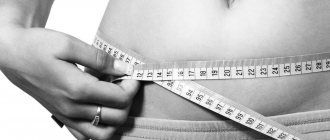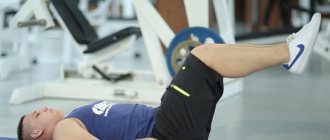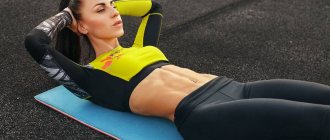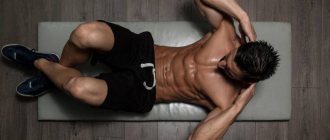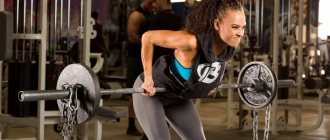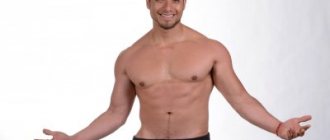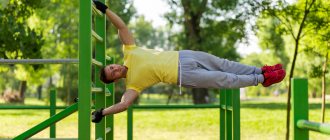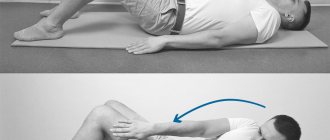Frog crunch
- Sit on the floor, placing your weight on your sit bones. Bend your back to maintain balance, bend your knees and lift your feet off the floor.
- Exhale, draw your belly button toward your spine and lean back, opening your arms and straightening your legs.
- Inhale and return to the starting position with your knees near your chest.
- Repeat 20 times.
The best exercises to quickly pump up your abs at home
What are the best exercises to pump up your abs at home?
Classic basic exercises will be crunches (another name is crunches, from crunch - “crunch” or “creak”) in various variations and planks. But this article will, of course, talk not only about them. Perform classic crunches on an inclined bench or on a straight surface (for example, on a carpet) in a short amplitude, slightly lifting your body from the floor.
Twisting (crunches)
This is a really important point because usually strength exercises are performed through a full range of motion, such as biceps curls. Here the movements should be short for the simple reason that the abdominals are a short, small muscle and must be kept in tension constantly.
Let's also consider interesting twisting options for beginners at home.
Bike
- Lie on the floor, press your lower back to the floor, put your hands behind your head.
- Pull your knees to your chest and lift your shoulder blades off the floor.
- Straighten your right leg low from the floor, and turn your body to the left, touching your right elbow to your left knee. This movement rotates the entire chest, not just the elbow.
- Perform the exercise in the other direction. This is one repetition.
- Complete 25 reps.
Press exercises, training features, anatomy
Rectus abdominis muscle
The motor function of this muscle is carried out in the “twisting” of the body relative to the hips and, conversely, the thighs relative to the torso. Exercises for the rectus muscle are divided into two types. Some load the upper region of the rectus muscle, others - the lower. So, when performing classic crunches, the rectus muscle tenses along its entire length, but its upper section takes on the most load. And, conversely, reverse crunches, when pulling the knees to the chest, place more load on the lower part of the abs. Thus, strengthening the rectus abdominis muscle will help you achieve better physical shape in those athletic disciplines that require running, jumping, lifting weights, etc.
Oblique internal and external abdominal muscles
The external oblique muscles “hug” the body on the sides; they run diagonally relative to the rectus abdominis muscle. Directly below them is the internal oblique muscle, its fibers running at an opposite angle to the external obliques. Thanks to this device, the multidirectional internal and external oblique muscles help each other. These abdominal muscles tilt, flex and rotate the torso. When some muscle groups perform dynamic work, others tense statically, thereby stabilizing the body. Strengthening these muscle groups will allow you to achieve success in tennis, golf, baseball, etc. It will be easier for you to perform activities in those sports that require rotation of the body.
Intercostal muscles
The intercostal muscles belong to the group of deep pectoral muscles. These are short muscle fibers that connect the rib bones. Their function is simple, but very important - to ensure the movement of the chest during breathing. It is quite difficult to pump up these muscles; the list of exercises to strengthen them is not wide. Basically, they are all associated with tilting the chest towards the pelvis: for this, the body will need to be bent and twisted. There are no isolated exercises for the intercostal muscles; in any case, the oblique abdominal muscles, the serratus chest muscles, and many other areas of the body will also be involved.
Transverse muscles
They run horizontally relative to the abdominal wall. The fibers of these muscles are directed transversely. Therefore, no amount of twisting can pump them up. The task of the transverse muscles is to protect our intestines from shocks when running and walking, as well as to increase intra-abdominal pressure when exhaling.
Reverse crunches
- Lie on the floor, place your arms on either side of your body, palms down.
- Raise your legs with your knees bent so that they are at chest level.
- Lift your hips off the floor, lifting your legs higher.
- Lower your legs back to the floor and repeat 2-3 times.
- Do not use inertia, the movement must be performed using the muscles, so perform it slowly.
Come to Sushka
DRYING – a special set of exercises + a proper nutrition system to improve relief and muscle development. A great opportunity to tone yourself up and get rid of a few extra pounds.
Find out more about the Drying program.
Now about the exercises and how to use them. Try to carefully read the descriptions of exercise techniques so as not to lose effectiveness!
And you don't need to use all these exercises at once. It is enough to choose 2-3 and perform them according to the prescribed scheme of approaches and repetitions 3-4 times a week. Better every other day.
Cross fold
- Lie on the floor, straighten your legs, place your arms along your body.
- Slowly lift your body and right leg. Turn your body to the right and touch your right foot with your left hand. Hold for one second.
- Also slowly lower yourself back to the starting position and repeat on the other side.
- Perform the exercise 15 times, alternating sides.
Fold in prone position
I bet no trainer has ever shown you abdominal exercises like this! And completely in vain. This exercise combines good muscle stretching and powerful contraction.
Execution: take a lying position, as for push-ups.
Perform a fold by lifting your pelvis up and feeling the contraction of your abdominal muscles. Then gently lower your pelvis down, feeling a good stretch in your abdominal area. Try to keep your legs straight. Continue to smoothly raise and lower your pelvis, contracting and stretching your abdominal muscles. In this exercise, the abdominal muscles work with the widest amplitude of all known exercises.
If you feel tension or pain in the lower back, stop exercising for a while.
The fold in the prone position should be performed smoothly - in 3 sets of 12-25 repetitions or more.
Slow leg lift
- Lie on the floor, lift your straight legs up, arms along your body.
- Press your lower back to the floor, slowly lower both legs, then raise them just as slowly. The slower you move, the more difficult the exercise.
- Repeat 10–15 times.
- If you want to make the exercise more difficult, do not lower your legs to the floor, hold them at an angle of 20-30 degrees, and then raise them again. In this case, the abdominal muscles will not relax throughout the entire exercise.
Lying straight leg raises
Raising your legs while lying down is very useful if you have insufficient lumbar lordosis. And, on the contrary, refuse this exercise if your lumbar lordosis is too pronounced, and during the exercise you feel tension in the lower back.
Execution: Lie on the mat with your feet together. Raise your head off the floor and bend your elbows as shown in the photo. If it is difficult to hold your head, place your hands behind your head and support it with your palms.
Smoothly raise and lower your straight legs, lightly touching your heels to the floor. When raising your legs, exhale, when lowering, inhale.
Once again, I note that the exercise is performed smoothly - 3 sets of 12-25 repetitions.
Raising arms and legs
- Lie on your stomach, raise your arms above your head. Lengthen your belly to protect and lengthen your lower back. Raise your legs, arms and head straight.
- Raise your right leg and left arm a little higher, then lower them lower and lift your left leg and right arm.
- Continue to slowly alternate arms and legs, do not dangle, keep your body in place.
- Repeat 20 times.
If you want to increase the load, try abdominal exercises with dumbbells and a medicine ball, or do abdominal exercises while standing. And don't forget about your diet! Even super intense exercise will not give you beautiful, sculpted abs without proper nutrition.
Lying crunches
Among all other abdominal exercises, this is the most common and effective. But provided that you do it correctly!
Execution: lie on the mat, hands behind your head, legs bent at the knees.
It is necessary to take in air and stretch the chest. Then, as you exhale, lower your chest and lift your body slightly, lifting your back off the floor.
The most important thing is that the length of your abdominal muscles should change when performing the exercise. When twisting, they should shorten and contract as much as possible, and when returning back, they should lengthen and stretch. Do not try to lift your body too high when doing crunches. This is not required.
Pay attention to the position of your head and hands. You should not pull your head with your hands! The head rests freely on the palms and rises only slightly along with the body. Look up. Keep your elbows out to the sides at all times.
Crunches are usually performed at a slow pace with full amplitude - 3 sets of 12-25 repetitions.
Where to pump up your abs - in the gym or at home
Muscles don't care where you train them. But doing abdominal exercises in the gym is more convenient for several reasons:
- a large number of different exercise machines, as well as mats, rollers and other equipment;
- motivating atmosphere - everyone around is tensely pumping their muscles;
- a lot of free space - no need to try to squeeze between the sofa and the TV;
- the opportunity to seek advice from a trainer or “spy” on the correct execution of exercises;
- large mirrors - you can always evaluate your equipment from the outside and correct mistakes.
Abdominal training in the gym is more productive, because there you can use several machines at once, working your muscles in different ways, and do energetic leg swings without the fear of hitting furniture or your beloved cat. If you can do all this at home, then the gym is not so necessary - after all, you can train online with a trainer.
View trainer profiles
